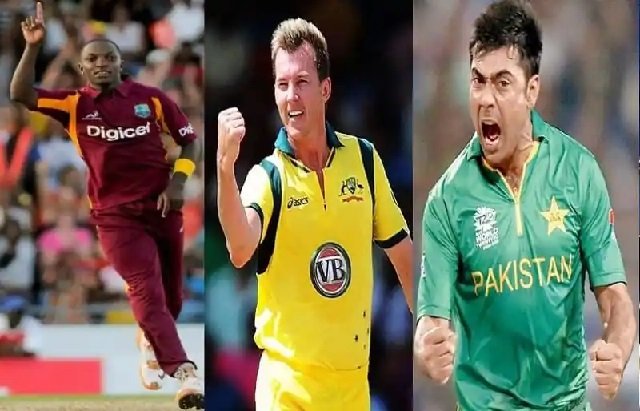As the bat has recently surpassed the ball in limited-overs cricket, a potent bowling unit is now necessary for victory in ODI World Cups. You can checkout the ICC t20 world cup 2023 news for staying updated with the latest happenings in the tournament. Check the following list of great bowlers.
- Imran Tahir
Imran Tahir has excelled in a South African side brimming with gifted fast bowlers.
Imran Tahir, a dexterous leg-spinner, has frequently succeeded when it counted most. Tahir has shown that there is always opportunity for slower bowlers to prosper in a nation brimming with high-quality fast bowlers. Armed with a highly menacing googly and contagious zeal, he has bamboozled several batsmen in the flagship tournament, entering the top 10 list of World Cup wicket-takers during the present 2019 season.
- Mitchell Starc
Mitchell Starc has taken 37 wickets in only 14 World Cup matches to thus year.
Mitchell Starc, who is generally considered as a destructive bowler, has a propensity to improve his game in World Cups. In only 14 matches between 2015 and 2019, he has amassed a staggering 37 wickets, owing in no little part to his unerring ability to strike a toe-crushing yorker. It would be an understatement to suggest that he was vital in Australia retaining the trophy at home in 2015; after all, he was voted Player of the Series for his 22 wickets at 10.18 and a 17.7 strike rate! He is likely to finish as the top wicket-taker in the 2019 World Cup for the second consecutive time.
His best ODI bowling stats were against New Zealand in a dramatic low-scoring match in Auckland during the 2015 tournament. At 131-4, it seemed that New Zealand would easily surpass the objective of 152. But Starc returned and shook up the lower order, leaving them reeling at 146-9, before Kane Williamson kept his cool to lead the hosts to victory.
- Allan Donald
Allan Donald was dubbed “White Lightning” due to his remarkable speed.
Donald is South Africa’s most productive bowler in the tournament’s history. He began his World Cup career in 1992, taking 13 wickets at an average of 25.3 runs each.
But, his most (un)famous World Cup moment was with the bat in the semi-final between South Africa and Australia in 1999. Donald, having taken 4–32, was in the non-striking end with three balls remaining and the scores tied. Lance Klusener hit the ball straight down the field and started to run for a single, but Donald, who was focused on the ball, missed the signal to run.
- Javagal Srinath
Srinath is the first Indian fast bowler with four World Cup appearances.
Javagal Srinath is the only Indian fast bowler to have participated in four World Cups between 1992 and 2003. He is often overlooked while discussing the quicks of the 1990s.
The right-arm fast played his last ODI in the 2003 World Cup and was the tournament’s best wicket-taker for India. In spite of being costly in the final, when he took no wickets and allowed 87 runs in an Australian triumph, he was able to achieve this. In the 2003 edition, Srinath got 16 wickets at an average of 23.06 and an economy rate of 4.04.
- Zaheer Khan
Zaheer Khan took 2-60 as India won their second World Cup in 2011 thanks to India’s victory.
Zaheer Khan contributed to India’s advancement to the 2003 World Cup finals and concluded the tournament as the fourth-highest wicket-taker with 18 scalps from 11 matches at an average of 20 runs per scalp.
Khan was instrumental in India reaching the World Cup finals in 2003 and 2011, the latter of which they won. Together with Oram, Khan has participated in the fewest World Cup editions, appearing in just 23 matches, which makes his 44 wickets even more noteworthy.
- Chaminda Vaas
Chaminda Vaas has been instrumental to most of Sri Lanka’s World Cup victories. Sri Lanka has a lengthy and prosperous World Cup history. Vaas will be recognised as his country’s most prolific fast bowler, frequently bowling in combination with Muttiah Muralitharan. Vaas’s ability to avoid being overshadowed by Muralitharan, the world’s most successful bowler, is a credit to his skills.
2003 was Vaas’ most successful event, as he helped his team reach the semifinals and took 23 wickets at an average of 14.39.
- Lasith Malinga
Malinga is the only participant on this list who has not yet retired from international cricket.
With his trademark low-arm slinging movement and ability to take wickets, Malinga has become the face of Twenty20 cricket, but he has also performed well for Sri Lanka in World Cups. In 2011, despite his team’s loss to India in the final, he took 13 wickets at a rate of 20.76 despite being renowned for his vast and lethal variations, most notably slower-balls and yorkers.
- Wasim Akram
Akram helped Pakistan win the World Cup in 1992.
Wasim Akram, perhaps Pakistan’s finest bowler, participated in five World Cups between 1987 and 2003. At the 2003 World Cup, Akram became the first bowler to amass 500 wickets in One-Day International cricket. He was renowned for his tremendous speed and mastery of reverse swing.
Wisden published their lone ranking of the greatest footballers of all time in 2002. Wasim was regarded as the top bowler in ODIs with a rating of 1223.5, surpassing both Glenn McGrath and Muttiah Muralitharan. In the 1992 World Cup final, Akram memorably got two crucial wickets in two balls, turning the match in Pakistan’s favour and delivering the trophy for the first time.
- Muttiah Muralitharan
Muralitharan won the World Cup for the first time in 1996, but he lost the final in 2007 and 2011.
Muttiah Muralitharan, one of just two spinners in the top ten, was Sri Lanka’s talisman for more than 15 years, especially during the World Cup, when he took 68 wickets at the lowest economy rate of any player on this list.
Muralitharan never took a World Cup five-for despite being second, but his bowling skill was unquestioned. Muralitharan, who finished with the most Test and ODI wickets, was among the top five wicket-takers in each of his last three tournaments. The 2007 tournament was statistically his most successful, as he got 23 wickets at an average of 15.26.
- Glenn McGrath
In 2003, Glenn McGrath ended with 7 for 15 against Namibia.
Glenn McGrath has the most wickets and the best statistics in World Cups. The pacer reached the final in each of the four World Cups he participated in, winning three of them.
McGrath has the rare distinction of having taken a wicket off the last ball of his Test and T20I careers. In his final ODI, against Sri Lanka in the 2007 World Cup finals, he claimed a wicket off his penultimate delivery. He received the Man of the Match award for his superb bowling, which contributed to Australia’s third consecutive victory in the event.



